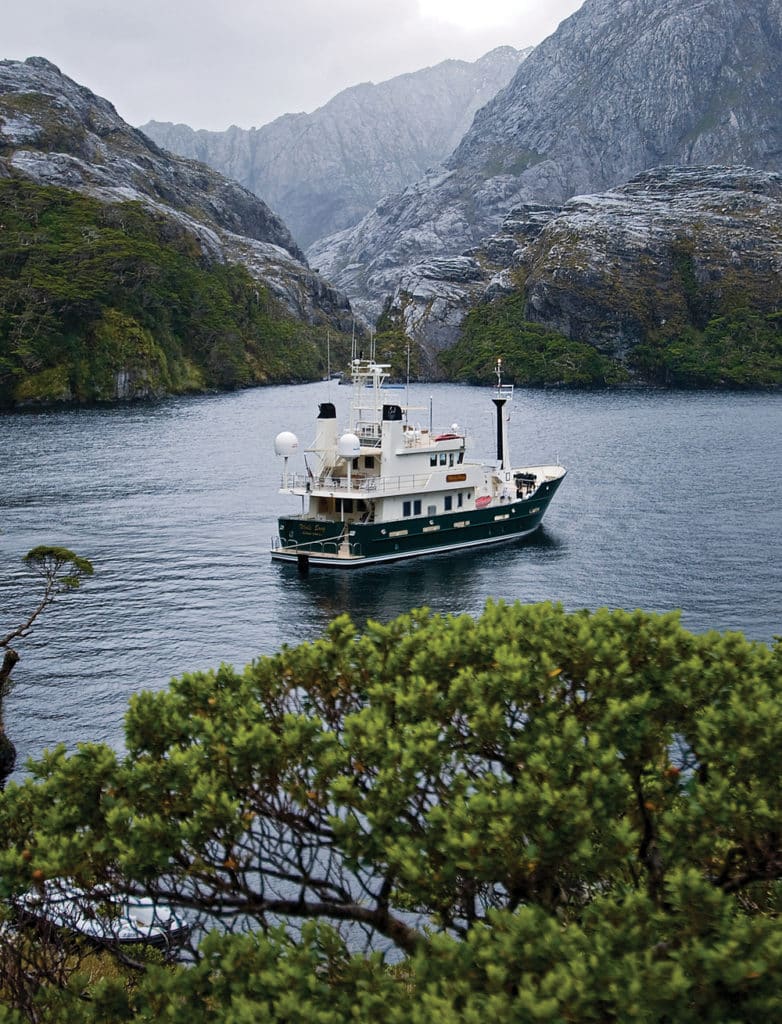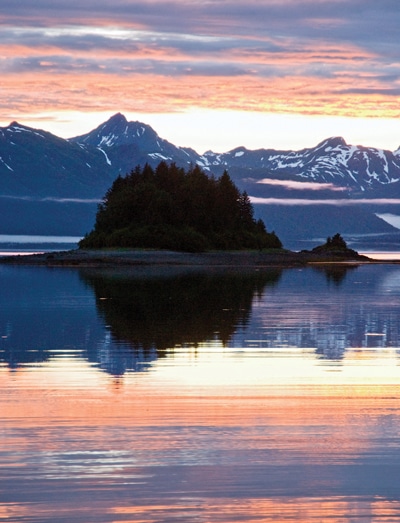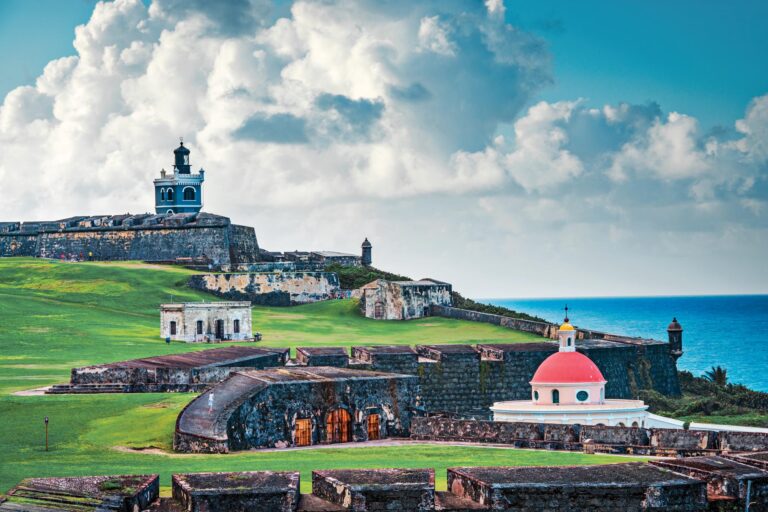
Around the World Aboard Whale Song
In our May issue, Tom Zydler recounted the first portion of Whale Song’s great round-the-world adventure. The 94-foot Trinity Halter expedition yacht was carefully refit for the rigors of voyaging in extreme climates and sea conditions. Then off they went — owner Grant Wilson, captain Tom Zydler and first mate Nancy Zydler, Tom’s wife — from New England to Antarctica, where we now rejoin the voyage.
Cape Horn To Puerto Montt
The great swells of the Drake Channel died down. The hulk of Cape Horn, Tierra del Fuego, loomed abeam. At midnight the overcast sky slid open, revealing the glowing tail of Comet McNaught over the famous rock — an unforgettable finale to our Antarctic voyage. At the end of January 2007, we were just returning north from an attempt to penetrate Antarctic Sound. Whale Song couldn’t break through the dense ice into the Weddell Sea. This foray had brought us into a universe of free-floating ice — flat-top ice cliffs the length of the English Channel filled the northern end of Bransfield Strait.
The Drake Channel treated us well in a season that saw the giant cruise ship The World forced into storm mode and the huge Stadstam beaten back into Argentina’s Ushuaia with 20 injured passengers. We wouldn’t encounter killer waves in our next venture through the Chilean Channels, just a certainty of screaming winds in fast-moving waters between iron-bound shores and piles of rocks.

Westbound from Ushuaia in the Beagle Channel for the Strait of Magellan, Whale Song steamed past glaciers in Brazo Noroeste. Their monumental size reduced a cruise ship in Seno Pia, Chile, to toy size. We had Seno Garibaldi all to ourselves, the bow right up there when a buttress of ice collapsed with a boom, sending waves rolling across the formerly still water. A low, dark sky let go sheets of water as we anchored Whale Song and then ran stern lines to the tortured vegetation at the base of sheer rock spewing cascades of rain. This weather continued, but the surrounding islands kept the seas down until the U-turn northward around Chile’s Peninsula Brecknock exposed the full swing of swell from the Southern Ocean. Then in the Straits of Magellan williwaws knocked Whale Song over like a sailboat. Our stern lines on 600-foot reels were in daily use because of the abysmally deep anchorages. In Puerto Profundo, with the bow yards from the shore, we dropped anchor in 180 feet while the stern swung over an underwater canyon — we were thankful Whale Song carried 800 feet of chain on each anchor.

Powering northward brought improving weather and prolific bird life — the bow wave sent flightless steamer ducks into a frenzy of wings pummeling the sea into froth. North of 50 degrees south it became balmy. In Seno Ringdove two Commerson’s dolphins led Whale Song into Richmond Cove and then mouthed the stern lines taken ashore in the tender. Farther north, forests covered the highlands, and from Isla de Chiloe to Puerto Montt in southern Chile the scenery turned bucolic: tilled fields, salmon and mussel rafts, and hamlets. Only white-capped volcanoes in the background hinted at the forces under ground. A year after our departure, earthquakes shook southern Chile, mercifully bruising Puerto Montt only lightly. The yacht facilities in town make it a base for heading south — the equivalent of Ushuaia in the Beagle Channel.
Puerto Montt To The Galápagos
Whale Song took Canal de Chacao with a fair tide and it spat us into the Pacific at 18.5 knots! As we headed north through Chile and Peru, all our thoughts focused on the Galápagos Islands. On the fourth day out of Salaverry, Peru, Whale Song passed Isla Española, part of the Galápagos, surrounded by rafts of albatrosses on the waves. It was April and the birds had arrived for their annual spree of mating rituals. We had reached this unique place where animals have no fear of humans, but we couldn’t land before taking aboard a licensed naturalist and creating a cruise plan approved by the national park.
Grant Wilson’s family — five grandchildren, ages between 2 and 8 — joined the yacht. They soon braved equator baptisms as Whale Song frequently crossed the line. The kids’ interaction with animals was amusing. On Isla Santa Fé, the tiniest sea lion pup waddled up to one of our boys — he withdrew in fright. To one side, a small sea lion played like a flamenco dancer with a discarded handkerchief and our little girls had to be restrained from hugging it. In fact, the girls were ready to kiss even the crusty, spiny marine iguanas lined up on the rocks of Espinosa Point, Isla Fernandina. Across the water, on Isla Isabela in Caleta Tagus, crews of long ago had painted the name of their ships on the smooth rock face. Grant, looking at the cliff, suddenly called with excitement, “Hussar 1932!” His grandfather had skippered the yacht Hussar, owned by E.F. Hutton and Marjorie Merriweather Post, which was renamed Sea Cloud after they divorced. It still roams the oceans.

For most people, the much filmed and photographed Isla Bartolomé and Pinnacle Rock are the Galápagos. The volcanic wasteland and cinder cones above the anchorage, the view of lava fields on Isla Santiago and the periodic violent eruptions on Isla Isabela made us think that any minute we could vanish into the underworld. Meanwhile, life went on. A new crop of hatched turtles kept bumping into our underwater lights. We shut off the lights and the baby turtles swam away to a chorus of “best of luck.” Before we left the islands, minutes after a tight squeeze between sharp rocks, the starboard rudder jammed hard over — a DC converter board had failed. We pushed and locked that fin in the amidships position and continued with the port rudder, feeling glad to have two of everything.
The Galápagos To Port Townsend
Antonio Moreano, our naturalist guide and a friend from previous visits, remained with Whale Song for the 300-mile northward trip to Isla del Coco, Costa Rica. He had something to show us. Late on the day we arrived, as the sun dimmed behind the western horizon, we donned scuba gear and slipped in. Our dive lights lit up the white-tipped dorsals of hundreds of sharks milling around. Though bunched tightly, they swerved miraculously to avoid collision; only rarely could I feel the silky touch of a tail.
With more than 4,000 miles north to reach Port Townsend, Washington, for the annual overhaul followed by a cruise of Alaska and a hop to Japan, Whale Song wasted little time lingering. Still, we roamed through Panama’s Isla Coiba, once a prison island and now a national park of virgin forest with howler monkeys, sloths and curassow birds, and then crossed the Hannibal Bank to see billfish jumping and swung into Bahia Rincón and Golfito, Costa Rica. We hugged the beach through the Gulf of Tehuantepec to avoid getting nailed by the notorious storm-force winds. After fueling in Cabo San Lucas, Mexico, I expected to hit rough water. It came a little later than on my previous trips. The north-northwest wind muscled up to 25 to 30 knots soon after Drake Bay, Point Reyes, California. Black-footed albatrosses wheeled through sea troughs, and Dall’s porpoises rode the foaming crests. Whale Song traveled with less grace. The seas, high and steep, pounced on the bow and swooshed up to the pilothouse windows for the next 300 miles. We were glad when we reached Port Townsend for a rest and repairs.
The Inside Passage To The Aleutians
The first week of July, less than a month after our haul-out and repairs in Port Townsend, Whale Song was powering through the Inside Passage of British Columbia to Alaska. In Tracy Arm, Alaska, we switchbacked between waterfalls roaring out of monolithic rocks and forests spitting out ribbons of glacial streams until the bow wedged into thick ice brittle, a quarter-mile short of the glacier’s snout. Across from the entrance to Glacier Bay, off Point Adolphus, feeding humpbacks breached in all directions. Dense ice barred access to McBride Glacier in Glacier Bay National Park, but our tender went in through the openings, zigzagging all the way to the snout when, with a cannon boom, a section broke off, igniting waves of colliding ice floes.
Seas in the Gulf of Alaska slumbered as Whale Song steamed north along the untamed, pyramidal skyline of Fairweather Range (15,000 feet). Lituya Bay still bears the evidence of the 1,720-foot tsunami that followed an earthquake in 1958. The aptly named Icy Bay was chocked with heavy ice, with barely a spot to anchor. The Columbia Glacier’s growling river of ice sparkled in the summer sun shining over Prince William Sound, a bulwark of turreted bergs barring access to the snout.
We were looking forward to seeing grizzlies. In Hallo Bay, across from Kodiak, several males and a sow with cubs fed on salmon that had been stranded on a beach at low tide. There is inherent safety in watching bears from the water, yet a tour boat nevertheless landed its people, who then foolishly wandered inland, blocking the bears’ retreat route. In Geographic Harbor a solitary male paid our tender no heed, too busy pawing salmon streaking by in a fast stream.
In the first days of August, Whale Song reached the Aleutians. A southerly gale blew away the summer calms. In the lee of Akutan Island, 50-knot williwaws twirled the sea into spinning whips. Despite spectacular steep mountains all around, Dutch Harbor felt too utilitarian and industrial to stay long. Westward we went on an empty sea, passing horned puffins by the dozen and sooty shearwaters by the thousands, as well as smoking volcanic cones along the starboard beam. Whale Song entered the Northwest Pacific through Tanaga Pass — our last images of Alaska were barking sea lions on Tag Island and the black mound of Gareloi volcano waving a banner of smoke.
The Aleutians To Subic Bay
A day after the Aleutians, we lost a calendar day crossing 180 degrees of longitude into the Eastern Hemisphere. The gray North Pacific was alive with birds. Laysan albatrosses hardly moved a wing coasting over swells; predatory fulmars boomeranged between sea and sky; our props stirred up food and cuddly kittiwakes followed, as did those walkers-on-water, the tiny storm petrels. A frontal passage brought a 12-hour northwest gale with big swollen seas and a salty tang in the air.
The landfall off Hokkaido, in northern Japan, gave us a taste of unyielding bureaucracy. “Your insurance company is under review for approval,” I was informed by our agents.
“No problem,” I said. “We’ll anchor for the night near Kushiro.”
“Don’t; you’ll be arrested,” was the response. So all night we dodged squid ships, glowing in the fog under clusters of spotlights and clanking machinery, jigging batteries of hooks. Always polite and smiling, the Japanese people made up for their stiff regulators. In Kushiro a man ran up to us and presented us with an origami crane; the taxi driver we had hired came to say goodbye with a bag of good-luck charms — plastic, gaudy and made in China! Our translator organized a dinner in his island village — a feast of fried fresh catch from Japan’s inland sea: whelks, oysters, soft shell crabs, shrimps and undersea spiders, centipedes and other stranger crawlers.

The coasts of Japan are very populated, contained and tamed in concrete. Great numbers of small freighters work the coastal waters, and they, bearers of the kamikaze spirit, gave no quarter when screeching around headlands, rocks and buoys. The cruising had a decidedly urban flavor — we were directed to go from one marina (large and efficient) to another. Whale Song wasn’t supposed to anchor but we managed: once off a yacht club’s moorings, once unnoticed in a night downpour and the third time for an hour before a patrol boat directed us inside a walled typhoon shelter. After the clean, pollution-free cities, our last stop, the tropical city of Okinawa — where plastic trash was blowing in the streets and an oppressive smog hung in the air — was a shock.
Between southern Japan and the Philippines, typhoons can whip up at any time of the year. Within 24 hours of Whale Song‘s departure from Okinawa, an enormous ring formed around the evening sun; bands of cirrostratus like cosmic highways pointed south-southeast. Lekima, a named typhoon, was spinning 400 miles away. The quartering seas grew larger than any Whale Song had experienced yet, and the yacht surged wildly down waves. Crests broke against the hull, thudding against the Lexan storm covers on the deckhouse windows. Eventually the Philippines’ Babuyan Islands to the east blocked the big swells. However, a tropical depression ahead over Luzon was dumping torrential rains on Whale Song even after we docked in Subic Yacht Club. That system drifted westward, gradually developing into a 100-knot typhoon. Whale Song moved southward through the islands and away from yet another depression whirling itself into fury at the north. We looked forward to better weather on the way to Palau Islands, our next destination.
Whale Song’s cirucumnavigation adventure will continue in the July issue of Yachting.
Read Part One: From New England to Antarctica
Subscribe to the Yachting Life newsletter for cruising and chartering guides, new boat announcements, event updates, special offers and more!









